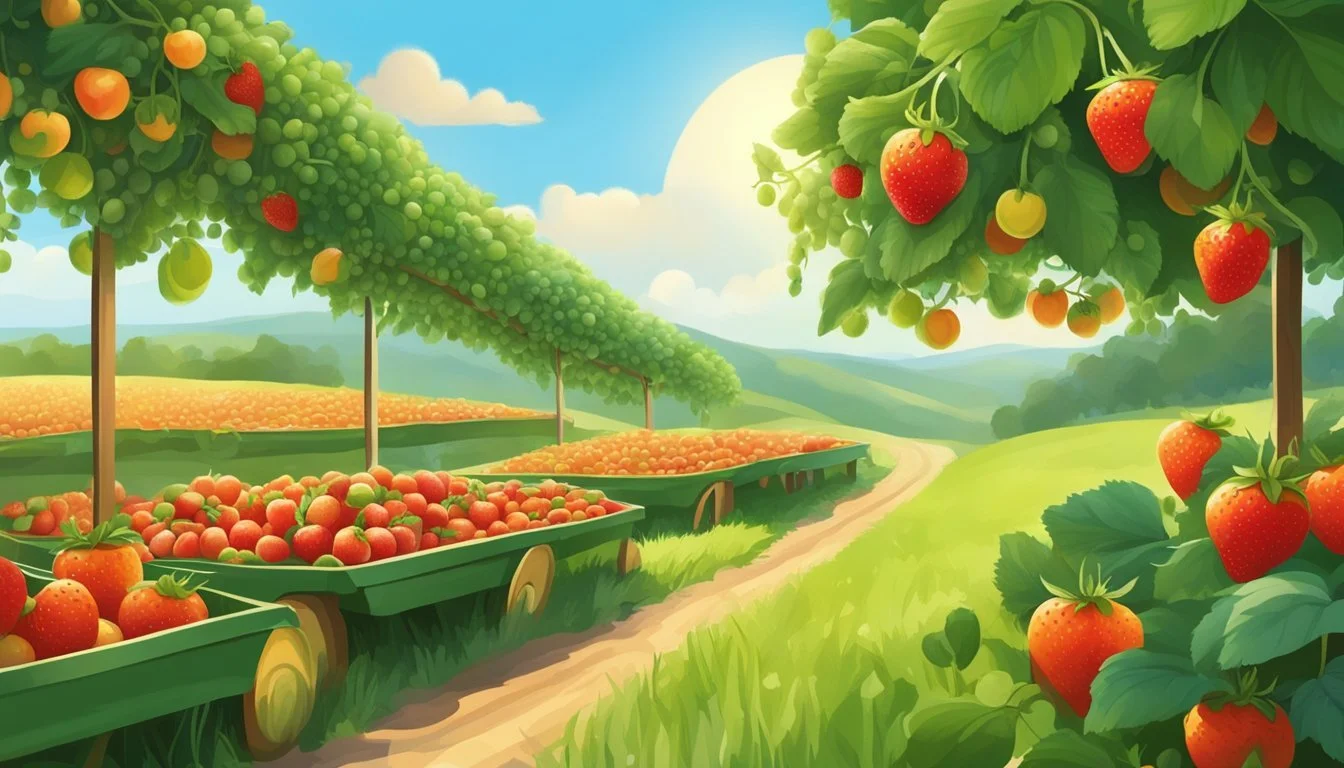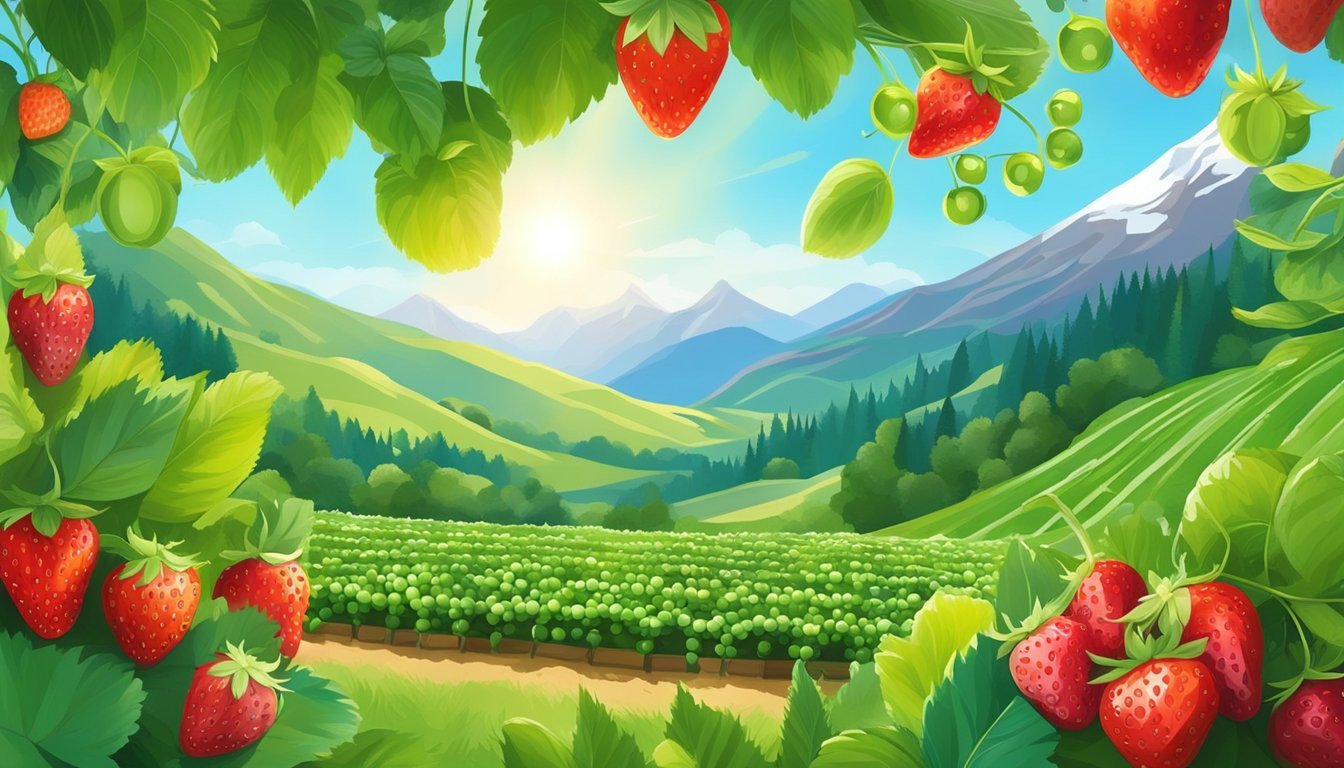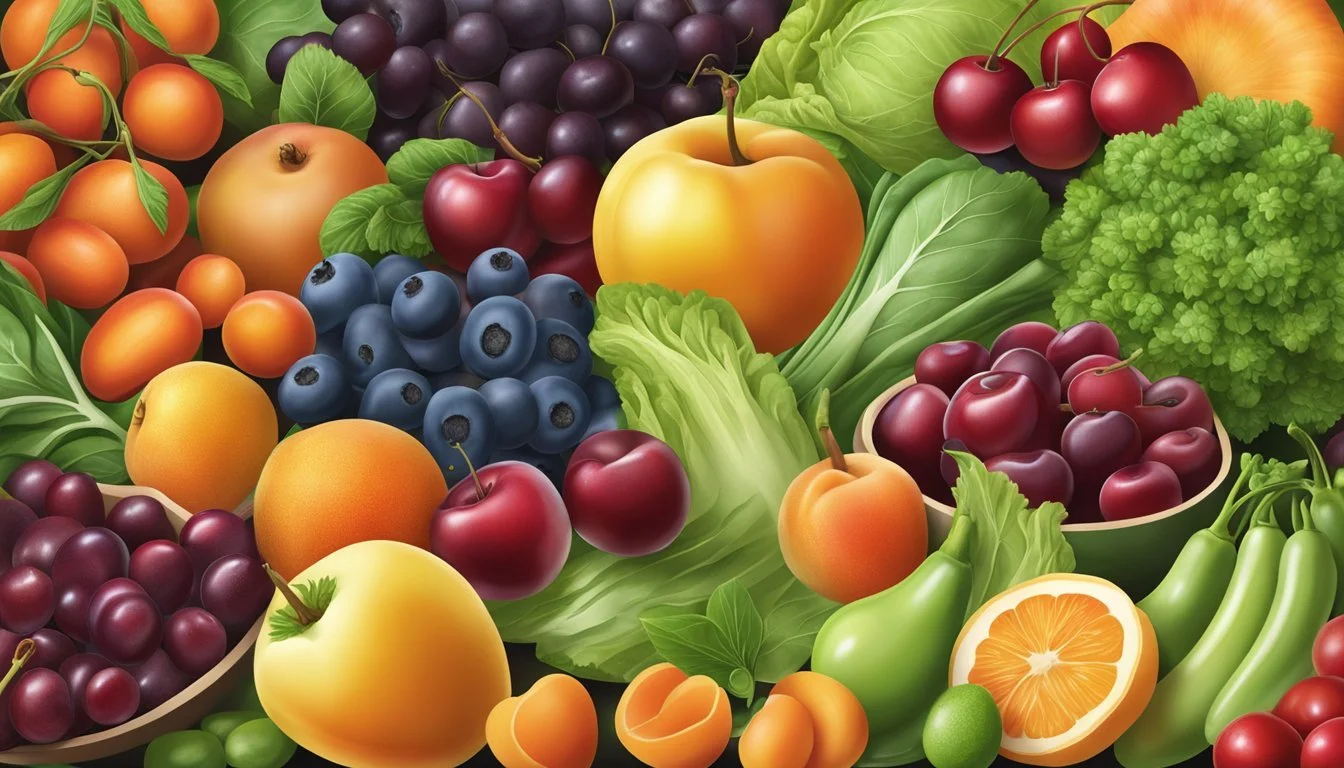Utah Seasonal Fruit & Vegetables in June
A Guide to Fresh Produce Selection
This Article is Part of our Utah Seasonal Fruit & Veg Calendar
As June heralds the start of summer in Utah, it brings with it an array of fresh produce. The shift in seasons is marked by longer days and warmer temperatures, factors that are conducive to the growth and ripening of a variety of fruits (What wine goes well with fruit?) and vegetables. Farmers' markets and grocery stores across the state begin to stock up on the seasonal bounty, providing an opportunity for residents and visitors to indulge in the freshest local flavors.
In Utah, June is particularly notable for its berries. Strawberries, blackberries (how long do blackberries last?), and blueberries make their anticipated entrance, offering a sweet and tangy delight that can be enjoyed fresh or incorporated into a multitude of recipes. This month also welcomes the first harvest of Utah's cherries (how long do cherries last?), a significant crop for the state that stands as one of the top producers of tart cherries in the nation.
Vegetables are not far behind, with the likes of beets, broccoli (how long does broccoli last?), and carrots arriving fresh from the fields. These vegetables, along with others like cauliflower and various leafy greens, are not only at their peak of flavor but also offer a wealth of nutritional benefits. They encourage a focus on healthful eating and support local agriculture, playing a pivotal role in Utah's seasonal eating habits.
Understanding Utah's Growing Season
The transition from spring to summer in Utah marks a significant shift in the growing season, influenced by temperature changes and the state's unique climate. This section provides insights into the key timelines and climatic effects on produce in Utah during these months.
Spring to Summer Transition
In Utah, the move from spring to summer brings a notable increase in temperatures, creating ideal conditions for a variety of fruits and vegetables to thrive. By June, the state experiences warm days that are conducive to the growth of many seasonal crops. This transition period often sees the tail end of spring produce and the arrival of summer varieties.
Effects of Utah's Climate on Produce
Utah's climate, characterized by its dry conditions and temperature fluctuations between day and night, plays a crucial role in the quality and types of produce available. For instance, the cooler nights of Utah summers contribute to the sweetness and concentration of flavors in fruits like cherries and strawberries.
Key Planting and Harvest Times
Spring Crops:
Asparagus: Plant in early spring; harvest starts in May
Radishes: Plant as soon as the soil is workable; mature in 3-4 weeks
Summer Crops:
Tomatoes: Plant after the last frost; harvest begins in late July or August
Peppers: Plant after the last frost; harvest typically starts in August
Apricots and Cherries: Start to ripen in June; picking season begins
Note: These timings are averages and can vary depending on specific weather conditions each year.
The state's vast temperature range allows for the successful cultivation of a diversified array of produce within the growing season, leading to a rich selection of fruits and vegetables for both local consumption and markets.
Fruits to Enjoy in June
June marks the arrival of a vibrant selection of fruits in Utah. This period is particularly notable for the fresh taste of locally-grown berries and the onset of stone fruit season, offering a diverse palette of flavors catered to fruit enthusiasts.
Berry Varieties
In Utah, June is prime time for berry harvesting. Fruit aficionados can expect a bountiful supply of strawberries, which are among the first to arrive on the seasonal fruit scene. Perfect for snacking, jams, and desserts, strawberries stand out for their sweetness and versatility. Meanwhile, other berries like blueberries and blackberries begin to flourish, promising richness in flavor and nutritional value.
Notable Berry Options:
Strawberries
Blueberries (toward the end of June)
Blackberries (toward the end of June)
Stone Fruits and Early Harvests
The stone fruit season also kicks off with cherries taking the center stage. They are celebrated not only for their delightful taste but also for their abundance in antioxidants. Following closely are apricots, which could be found at local farmers markets, introducing a tangy yet sweet profile perfect for various culinary uses. As June progresses, early varieties of peaches may also start to appear, hinting at the fuller harvests expected later in the summer.
Stone Fruit Selection:
Cherries
Apricots
Early Peaches
Citrus Fruits Availability
While Utah may not be renowned for its citrus production, certain grocers and markets will start stocking some out-of-state citrus fruits in June. These include options like oranges and lemons, which are typically sourced from warmer climates.
Citrus Insights:
Oranges (imported)
Lemons (imported)
The local harvests, especially berries and stone fruits, stand out in June, while citrus fruits are usually brought in from other regions to complement the local produce offerings.
June's Vegetable Bounty
In June, Utah's gardens are rich with a variety of vegetables that thrive in the moderate early summer climate. From leafy greens to robust root vegetables, local produce provides crisp flavors and essential nutrients.
Leafy Greens and Salad Essentials
Utah's June harvest offers an abundance of leafy greens. Lettuce varieties such as Romaine and Butterhead are at their peak, providing a crisp base for salads. Spinach and kale, rich in vitamins, are readily available, with the former adding tenderness and the latter a hearty texture to dishes.
Lettuce – Varieties including Romaine, Butterhead
Spinach – Tender and nutritious
Kale – Hearty and vitamin-rich
Root Vegetables and Tubers
The soil gives way to earthy treasures like beets and carrots in June. Beets, known for their deep red hue and sweet flavor, are versatile in the kitchen. Carrots offer a satisfying crunch and are perfect for snacking or adding sweetness to a range of recipes.
Beets – Sweet, vibrant, and versatile
Carrots – Crunchy and ideal for snacks or recipes
Cruciferous and Nightshade Vegetables
June also sees a range of cruciferous and nightshade vegetables. Gardeners can anticipate harvesting tomatoes and peppers, both members of the nightshade family, which are just beginning to ripen on the vines and add a splash of color and variety of flavors to meals. Zucchini and cucumbers, fast-growing and prolific, provide refreshing options for both raw and cooked dishes.
Tomatoes – Beginning to ripen, colorful
Peppers – A variety of flavors
Cucumbers – Refreshing, ideal for salads
Zucchini – Fast-growing, versatile in cooking
Herb and Aromatics Harvest
In Utah, June brings an abundance of both perennial and annual herbs, as well as a variety of aromatic plants that enhance the flavor of any dish.
Perennial and Annual Herbs
Herbs that return year after year, or perennials, alongside newly planted annuals, are ready for harvesting in June.
Basil (how long does basil last?) emerges as a favorite in summer cuisine:
Genovese: Ideal for pesto due to its full flavor.
Sweet Basil: A versatile variety used in a myriad of dishes.
Mint varieties are at their peak and include:
Spearmint: For a refreshing flavor in drinks and salads.
Peppermint: Stronger and more intense, suitable for medicinal uses.
For Parsley, June offers two popular types:
Curly Leaf: Decorative and with a milder taste.
Flat Leaf (Italian): Preferred for cooking due to its robust flavor.
Perennials to look for:
Chives
Oregano
Thyme
Annuals that thrive after June planting:
Cilantro
Dill
Aromatic Additions
Aromatics play a crucial role in culinary practices, elevating simple dishes with complex flavors. Gardeners can find several aromatic plants ready for harvest in June, which include:
Lavender: A sought-after aromatic for its soothing fragrance and culinary versatility.
Rosemary: Hardy and able to withstand the heat while offering a fragrant addition to meats and vegetables.
Sage: A robust herb, with a slightly peppery flavor, perfect for seasoning meats and sauces.
Planning Your Garden
June in Utah is an excellent time for gardeners to cultivate a diverse array of fruits and vegetables. Successful gardening this month relies on selecting the right crops, planting them strategically, and managing pests diligently.
Choosing the Right Plants
When selecting plants for the Utah garden in June, one should focus on heat-tolerant vegetables and herbs that thrive in warmer temperatures. Suitable examples for this period include:
Vegetables: Sweet corn, Swiss chard, and peppers.
Herbs: Basil and oregano, which can be planted to enhance various dishes.
Planting Strategies for Success
To ensure a bountiful harvest, certain planting strategies are recommended:
Successive planting: Planting crops like radishes and carrots in intervals ensures a continuous harvest throughout the season.
Spacing: Follow guidelines for spacing—peppers, for example, need ample space for optimum growth.
Moreover, one should always consider the soil condition and sunlight exposure of their garden when planting.
Pest Management and Care
Managing pests and providing proper care are vital for a healthy garden:
Regularly check for earwig damage on herbs and leafy greens.
Implement pre-emergent herbicides in late May to early June to control lawn weeds like crabgrass and spurge, following instructions carefully to prevent damage to garden plants.
A dedicated approach to these practices will greatly increase one's chances of a healthy and productive garden throughout the summer months.
Local Food Markets and Farm Stands
In Utah, June brings an abundance of fresh, locally grown fruits and vegetables available at numerous farmers markets and farm stands. Shoppers have the opportunity to buy directly from growers, ensuring peak freshness and variety.
Finding Fresh Produce in Utah
The state of Utah is dotted with farmers markets and farm stands offering a wide range of seasonal produce. Cities like Salt Lake City, Park City, and others in the region become hubs for fresh fruits and vegetables during June. Salt Lake City's Downtown Farmers Market at Pioneer Park is a popular destination where residents and visitors can find diverse selections from cherries to crisp greens. Additionally, countryside roads like Highway 89, known as 'Utah's Fruit Way', are lined with farm stands boasting ripe produce such as peaches, berries, and summer squash.
Key Markets for June:
Downtown Farmers Market, Salt Lake City: Offers cherries, peas, and more.
Utah's Fruit Way: Roadside stands selling locally grown stone fruits.
Supporting Local Agriculture
Purchasing produce from local markets and farm stands in Utah supports regional agriculture and contributes to the community. It enables farmers to sustain their operations and continue providing fresh food. Visitors to Tagge's Famous Fruit & Veggie Farms can enjoy not just the high-quality produce, but also the satisfaction of backing local growers. Patrons also appreciate the low prices and the innovative spirit that such local distribution exemplify.
Farm Stands Worth Visiting:
Copper Moose Farm: Known for its local organic produce and farm stand in Park City.
Tagge's Farm: Offers a full range of produce with commendable practices in local distribution.
Shopping at these venues allows consumers to enjoy the peak season's offerings while engaging with the community's agricultural roots.
Preserving the Harvest
June in Utah brings a bounty of fruits and vegetables to the table. Ensuring this harvest doesn't go to waste requires effective preservation methods. Home preservation allows these products to be enjoyed long after their season has ended.
Canning and Storage Techniques
Canning is a reliable way to preserve the freshness of Utah's June harvest. It involves processing foods in closed glass jars to extend their shelf life. There are two primary canning methods:
Water Bath Canning: Suitable for high-acid foods like fruits and tomatoes.
Process in boiling water for a time specified by a tested recipe.
Pressure Canning: Necessary for low-acid foods such as vegetables and meats.
Requires increased pressure (13-15 lbs. for dial- or weighted-gauges) to prevent botulism.
Storage Tips:
Store canned goods in a cool, dark place.
Always label jars with the contents and the date of canning.
Freezing and Drying Methods
Freezing and drying are alternative methods for preserving June's harvest.
Freezing:
Quick-freezing small pieces on a tray before storing them in bags helps prevent clumping.
Blanch vegetables before freezing to preserve color and nutrients.
Drying:
Foods can be dehydrated using a dedicated food dehydrator or an oven.
Ensure foods are completely dry to prevent mold.
Points to Remember:
Proper packaging is crucial to avoid freezer burn and moisture loss.
Store dried foods in airtight containers in a dark, cool place.
By employing these preservation techniques, one can ensure the harvest's longevity, offering the taste of June's bounty for months to come.
Health Benefits and Nutrition
In Utah, June marks the arrival of a vibrant array of fruits and vegetables packed with essential nutrients that contribute to good health. One can find a diverse selection that includes juicy blueberries, which are rich in antioxidants like vitamin C and manganese, supporting immune function and bone development.
Vegetables during this time also provide nutritional benefits, with items like broccoli offering high levels of vitamin K and folate, which are crucial for maintaining healthy bodily functions. Asparagus, another seasonal vegetable, is a source of fiber, folate, and vitamins A, C, and E.
Here's a quick glimpse of their nutritional profile:
Food Key Nutrients Health Benefits Blueberries Vitamin C, Manganese, Fiber Antioxidant properties, supports immune system Broccoli Vitamin K, Folate, Vitamin C Bone health, cellular repair, immune support Asparagus Fiber, Folate, Vitamins A, C, E Heart health, digestive support
Eating these fruits and vegetables during their peak season not only ensures optimal flavor but also guarantees a higher nutritional content. This seasonal diet diversification supports overall health, potentially reducing the risk of chronic diseases and aiding in maintaining a balanced diet. Consumers can confidently include these fresh produce items in their diet, taking advantage of their freshness and full nutritional value during the month of June.









